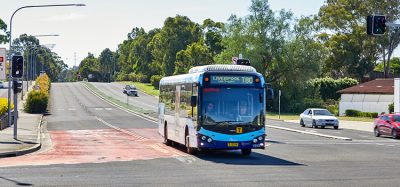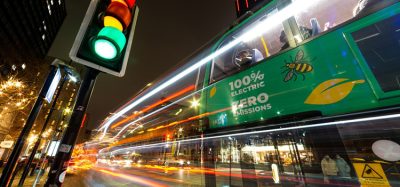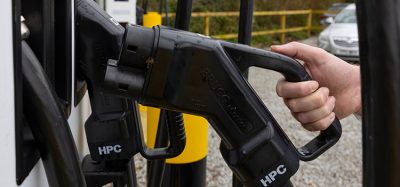Defining Mobility-as-a-Service: Its benefits, challenges and sustainable potential
- Like
- Digg
- Del
- Tumblr
- VKontakte
- Buffer
- Love This
- Odnoklassniki
- Meneame
- Blogger
- Amazon
- Yahoo Mail
- Gmail
- AOL
- Newsvine
- HackerNews
- Evernote
- MySpace
- Mail.ru
- Viadeo
- Line
- Comments
- Yummly
- SMS
- Viber
- Telegram
- Subscribe
- Skype
- Facebook Messenger
- Kakao
- LiveJournal
- Yammer
- Edgar
- Fintel
- Mix
- Instapaper
- Copy Link
Posted: 11 December 2023 | Sebastian Wolf - BVG | No comments yet
Sebastian Wolf, Project Lead – Jelbi App at Berliner Verkehrsbetriebe (BVG), provides insight into the evolving landscape of Mobility-as-a-Service and its transformative impact on urban transportation, shedding light on the core principles, opportunities and challenges that come with this ground-breaking concept.
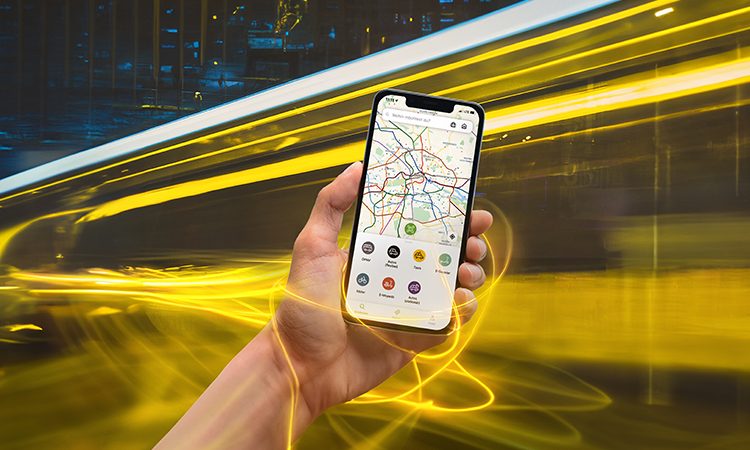

Credit: BVG
How do you define Mobility-as-a-Service (MaaS)?
At its core, Mobility-as-a-Service is the idea of demand-based transportation without individually owning the means of transport. This concept is especially attractive in dense urban areas like Berlin, where public space is simply too valuable to serve only as parking space for privately owned cars and where individual mobility needs are too broad to be effectively satisfied with a single means of transportation (e.g., a car).
With Jelbi, we have scaled our brand core into a holistic mobility platform and, with our MaaS App, we’re offering users a single interface to find, compare and use public transport and shared mobility”
As Berlin’s public transport authority, BVG has been in the business of providing reliable and affordable transportation to large numbers of customers for over 90 years. With Jelbi, we have scaled our brand core into a holistic mobility platform and, with our MaaS App, we’re offering users a single interface to find, compare and use public transport and shared mobility.
Furthermore, users can seamlessly access 90% of Berlin’s mobility options with a single account. We use Jelbi Mobility Hubs to embed the idea of shared mobility into the physical landscape of the city. Here, riders can start their ride, park their transport or transfer between different modes of public and shared mobility. In addition, our Jelbi Corporate Mobility Budget offers a solution for employers who aim to encourage their teams to use a sustainable alternative to the company car.
In this sense, we define and provide MaaS to our customers and users, our mobility partners, local business, as well as the city as a whole.
What do you see as the primary benefits that MaaS offers to both consumers and the transportation industry?
A digital MaaS platform like the Jelbi App lowers the entry barriers for consumers to discover, use and combine multiple modes of transport without having to install numerous native apps”
Ideally, MaaS and especially MaaS platforms act as an intermediary between providers and consumers. If we look at the City of Berlin and Jelbi as a digital and physical MaaS platform, there are multiple ways for all parties to benefit. A digital MaaS platform like the Jelbi App lowers the entry barriers for consumers to discover, use and combine multiple modes of transport without having to install numerous native apps. A single registration unlocks most of Berlin’s shared mobility seamlessly and enables users to choose what suits best for any given situation, rather than what a particular service provider has to offer.
Our Jelbi Mobility Hubs act as an amplifier by bundling mobility options physically, making it easy to rent, park or switch between modes. But they also provide an additional benefit. When opening a Jelbi Mobility Hub, we bring our mobility provider with us, introducing shared mobility to areas of the city where it had oftentimes not been available before.
Moreover, mobility service providers profit from Jelbi as an additional distribution channel, unlocking new target groups beyond their own native apps. But they also gain something that is becoming increasingly rare and valuable in inner-city areas: opportunities to place their vehicles in attractive and high-turnaround locations in our mobility hubs.
Lastly, Jelbi is an important ally for the sharing providers in creating a holistic mobility ecosystem for the city, where providers can thrive while at the same reducing conflict with other stakeholders like pedestrians and bike riders and their legitimate interests.
What role can MaaS play in promoting sustainable and efficient transportation options?
One of the key features of the Jelbi MaaS App (and some other MaaS products, as well) is to present multiple options of transport in a user-friendly and transparent way. In the Jelbi App, a route search function allows users to compare travel options with different or mixed modes of transport.
Usually, the indicators provided contains duration of travel, cost for public transit tickets and vehicle rent, number of transfers between lines, etc., enabling users to find the quickest, most affordable or most convenient route. With a suitable data source, this travel information could be augmented with sustainability indicators, such as CO2 emissions or electric versus combustion engine. This is not some technical gimmick without any relevance to the users; for example, recently, we have seen more and more user requests asking for sustainability data to help them to make an informed decision when picking a mode and route.
Of course, such information needs to be calculated with every route suggestion provided to a user, and the challenge when looking for suitable data to develop and implement such features lies in finding a source that is simultaneously technically available to allow for quick output and scientifically valid to allow users to trust the information. Once implemented, one could imagine different other functions on top of efficiency or sustainability indicators, such as dynamic pricing or rewards based on the choice of mode.
Another way to promote greener travel is to implement filtering or preference functions, harnessing the users’ intrinsic motivation to find and choose sustainable mobility options.
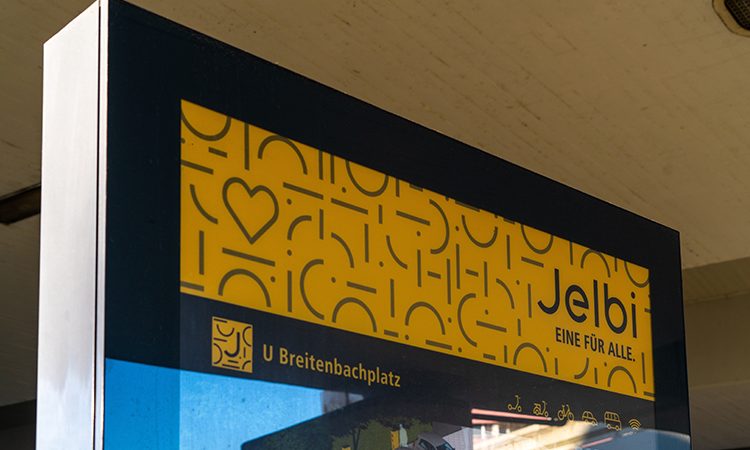

Caption: Jelbi is an important ally for sharing providers in creating a holistic mobility ecosystem for the city, where providers can thrive while at the same reducing conflict with other stakeholders like pedestrians and bike riders and their legitimate interests.
What are the main challenges and barriers that MaaS providers face in integrating various transportation modes (e.g., public transport, ride-sharing, bike-sharing, etc.) into a seamless and convenient service for users?
When it comes to technically integrating a service, the depth of integration and the scope of functionalities are major determinants of effort and should be derived from the MaaS provider’s platform strategy”
First of all, MaaS providers need to assess which level of integration they want and then choose or build a technical solution that supports that level. In areas with various mobility service providers (MSPs), a MaaS provider needs to develop a strategy for integrating specific types of MSPs, e.g., by defining criteria for minimum fleet size, business area or technical readiness. Platforms are complex constructs; therefore, business agreements and other contracts need to be negotiated before an integration can start technically.
When it comes to technically integrating a service, the depth of integration and the scope of functionalities are major determinants of effort and should be derived from the MaaS provider’s platform strategy. Some MSPs might offer more (or fewer) functionalities than desired for the MaaS platform, making user interface (UI)/ user experience (UX) adjustments necessary. Testing and launching a new service is another milestone that requires a co-ordinated effort of multiple stakeholders, especially when the developers are situated in a different city than the MaaS provider.
Even after a successful launch, the work does not stop, as managing a network of mobility partners is a constant task. Changes in the way the platform or individual services operate can require significant efforts, as can bugs or disruptions occurring along the way.
Lastly, one must keep in mind that the MaaS sector is very volatile and, in cities like Berlin, mobility service providers are continuously entering and exiting the market. Some forms of transport – like car-sharing, scooter-sharing and moped-sharing – have seen dramatic consolidations in the last few years. Consequently, there is always the risk of losing a service that was laboriously integrated.
Interoperability between different transportation providers is crucial for the success of MaaS. How can industry stakeholders work together to establish common standards and protocols that enable seamless integration of various mobility services?
As a single MaaS provider, operating a single platform in our city, we have been finding it difficult to be a driving party behind standardisation, as we are obviously only a tiny fraction of the MaaS sector. We feel that meaningful progress in terms of standardisation will require the genuine interest of large service providers, as well as large data and service operators or, alternatively, comprehensive regulation. Given the existential struggles that some players are currently facing and the aforementioned consolidation currently taking place, this might seem like a big ask.
At the same time, we are observing many cities and municipalities actively engaging in MaaS and regulating how new mobility can operate in their sphere of influence. The result might be an increasing number of local or regional platforms with more (and smaller) service providers required to integrate. Maybe this development will provide an impulse towards standardisation.
Data privacy and security are significant concerns in the MaaS ecosystem. How do you address these concerns while collecting and managing user data to enhance the MaaS experience?
When it comes to personal information, we operate our platform on a need-to-know basis, only collecting data that is needed”
As a city-owned company, BVG is aware of its responsibility in upholding user rights and privacy standards, and we take this responsibility very seriously. As a mobility platform, part of our business is connecting consumers and providers of mobility services. When it comes to personal information, we operate our platform on a need-to-know basis, only collecting data that is needed. Jelbi users can create an account with minimal personalisation and will only be required to add further information if they wish to use services that need that information. Sharing providers, on the other hand, individually receive the information that they need to fulfil their service only after users have actively agreed to that specific provider’s terms and conditions.
While we rely on data to analyse and develop our business, we ensure that the technology and processes employed to collect, store and process data is compliant with European, national and local legislation. As a standard, every technical development on our platform is assessed by legal and privacy experts to determine measures for a compliant roll-out (e.g., additional user consent).
While this thorough approach requires us to take additional steps in the conceptualisation and development phases, we believe that it is a sound investment in the trust that our users place in us as Berlin’s public transport operator.
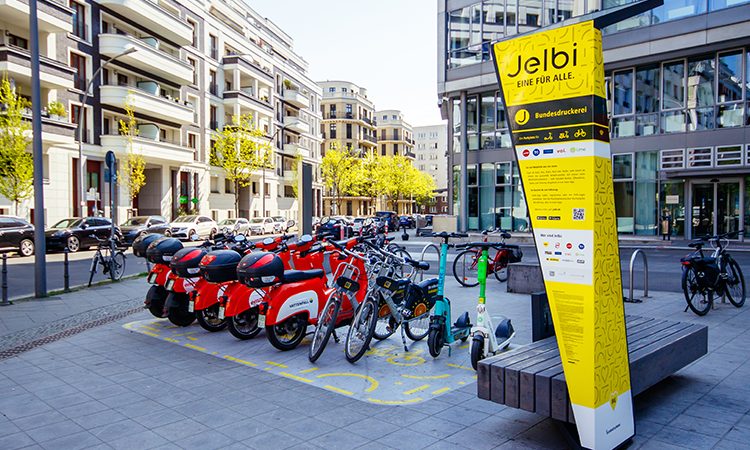

Credit: BVG, Elke Stamm – BVG uses Jelbi Mobility Hubs to embed the idea of shared mobility into the physical landscape of the city.
As MaaS relies heavily on digital technology and mobile apps, how do you ensure accessibility and inclusivity for all users, including those who may not have access to smartphones or the internet?
As a city-owned company, BVG is especially aware of the responsibility we have in terms of accessibility and inclusivity. First and foremost, this becomes visible in our own public transport services – with accessible vehicles, platforms, etc. – but also in our on-demand shuttle service, MUVA. However, our responsibility doesn’t end there, but extends to our MaaS platform, Jelbi. To ensure an accessible user experience on our website and MaaS app, we adhere to the international Web Content Accessibility Guidelines (WCAG). In addition, content on our website is available in sign language and plain language to ensure that we serve a broad variety of audiences.
Jelbi App users who are looking for barrier-free travel routes can find such connections by activating a toggle in our route search. Also, wheelchair-accessibility of vehicles is always indicated for all public transport trips displayed in Jelbi. When it comes to the sharing mobility services integrated in Jelbi, the level of accessibility depends on the respective providers. If accessibility options are provided (e.g., wheelchair access for on-demand shuttles), we support these options with suitable UI elements in the booking flow.
In the physical world, Jelbi Mobility Hubs play an active and increasing role in freeing Berlin’s pavements from parked bikes and scooters. Most recently, we have started the planning process for Jelbi Mobility Hubs with an increased focus on accessibility. To ensure that initiatives like these meet the needs of the relevant stakeholders, we are regularly aligning with accessibility experts within and outside of BVG.
We acknowledge that not all dimensions of inclusivity are currently covered in our MaaS approach. For instance, providing access to our booking platform to customers without a smartphone is not possible at the moment. However, our aforementioned on-demand shuttle, MUVA, can be booked with a regular phone call.
With the growing interest in electric and autonomous vehicles, how do you see these and other future technologies influencing the future of Mobility-as-a-Service?
Technological innovation has always been a driver of change in mobility, and electrification, as well as automation, are no exception”
Technological innovation has always been a driver of change in mobility, and electrification, as well as automation, are no exception. Especially in a city like Berlin, the electrification of private and public fleets is a significant factor in reducing the carbon footprint and reaching our society’s climate goals. At the same time, we witness users actively asking for and seeking out electric mobility options.
Autonomous vehicles and especially autonomous, electric shuttles are often referred to when utilising MaaS to improve mobility in rural or suburban areas. Several initiatives have been and are being carried out to determine the usefulness and viability of autonomous mobility in the Berlin area.
We are excited to see what the future of mobility holds.


Related topics
Accessibility, Micro-mobility, Mobility Services, Multimodality, Passenger Experience, Public Transport
Issue
Issue 4 2023
Related modes
Bikes & Scooters, Ride-sharing & Car-sharing
Related cities
Berlin
Related countries
Germany
Related organisations
Berliner Verkehrsbetriebe (BVG)
Related people
Sebastian Wolf




